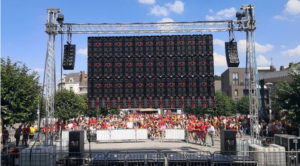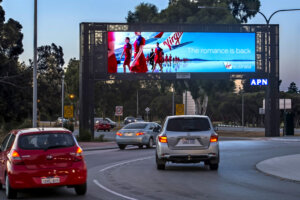
In today’s dynamic advertising landscape, digital billboards have emerged as powerful tools for marketers to capture attention, deliver impactful messages, and engage audiences in real time. Unlike traditional static billboards, digital billboards offer flexibility, creativity, and interactivity, making them a popular choice for brands seeking to make a lasting impression. If you’re new to digital billboards and wondering how to leverage their potential, this beginner’s guide will provide essential insights.
What are Digital Billboards?
Digital billboards, also known as electronic billboards or LED billboards, are large outdoor screens that display digital advertisements and messages. They use light-emitting diodes (LEDs) or digital displays to showcase content such as images, videos, animations, and text in high resolution. These billboards can be found in strategic locations such as highways, urban centers, shopping districts, and transit hubs, maximizing their visibility and impact.
Electronic billboards (or digital billboards) are used to deliver advertising and informational messages to drivers and passersby. These billboards utilize LEDs to display bright and highly efficient full-color imagery.
How do Digital Billboards work?
Digital billboards work by using light-emitting diodes (LEDs) or digital displays to showcase advertising content in outdoor locations. Here’s an overview of how digital billboards operate:
- Display Technology: Digital billboards typically use LED technology or large digital screens to display content. LEDs are preferred for outdoor use due to their brightness, durability, and energy efficiency. The digital display is composed of thousands of tiny LEDs arranged in a grid pattern.
- Content Management System (CMS): A content management system is used to control and manage the content displayed on digital billboards. Advertisers or operators can upload, schedule, and update content remotely using the CMS. This allows for real-time changes and flexibility in displaying different ads or messages.
- Connectivity: Digital billboards are connected to a network, usually via the Internet or a dedicated communication infrastructure. This connectivity enables communication between the CMS and the billboard, allowing for seamless content updates and monitoring of performance metrics.
- Brightness and Visibility: LEDs used in digital billboards are highly luminous, making them visible even in bright daylight conditions. The brightness level can be adjusted based on ambient light conditions to ensure optimal visibility and readability of the content.
- Power and Energy Efficiency: While digital billboards consume electricity to power the LEDs and display content, they are designed to be energy efficient. LED technology has improved significantly in terms of energy consumption, making digital billboards more sustainable compared to older display technologies.
- Content Rotation and Scheduling: Digital billboards can display multiple ads or messages in a rotation sequence. Advertisers can schedule different content to be displayed at specific times of the day or week, targeting different audience segments or promoting time-sensitive offers.
- Monitoring and Maintenance: Digital billboards are often equipped with monitoring systems that track performance metrics such as uptime, ad impressions, and audience engagement. Maintenance tasks such as software updates, hardware checks, and cleaning are also part of ensuring the billboard’s optimal functioning.
- Integration with Data Sources: Some advanced digital billboards can integrate with data sources such as weather updates, traffic information, or social media feeds. This integration allows for dynamic content updates based on real-time data, enhancing the relevance and impact of advertising messages.
By industry standard, billboards with LEDs are rented by minutes and each ad is shown for 8 seconds.
How much do they cost?
Digital billboards are still relatively new to the outdoor advertising scene – so compared to static billboards, they will be more expensive. That being said, as they become more and more common, the prices will continue to drop.
Numerous vendors supply similar but difficult to compare products at various prices. Even more so, most vendors are located in Asia, which means there is a longer lead time and you will not be able to see the product until you pay for it. Movia has an excellent LED Billboard Cost Estimator on their website, it should give you a good idea of what to expect to pay.
Where can I put them?
This is one of the greatest drawbacks to digital billboards, their installation is tricky. Their regulatory status will vary from municipality to municipality, and obtaining permission can take months.
For information about Toronto Billboard Advertising regulatory system, click here. You can also check out the “sign view” application on the city of Toronto’s website to find out exactly which by-laws apply according to geographic regions.
Advantages of digital Billboards
Like most out-of-home advertising mediums, digital billboards present an advantage because of their sheer size of potential audience. Depending on the size and display settings, your digital billboard could make a killing. They also allow messages to be posted quickly and low production cost of setting up a campaign. In fact, studies have shown that LED’s are six times more effective than traditional static billboards.
- Dynamic Content: Digital billboards allow advertisers to showcase dynamic content that can be updated, changed, or scheduled remotely. This flexibility enables real-time advertising, event promotions, and targeted messaging based on audience demographics or time of day.
- High Impact: With vibrant colors, motion graphics, and eye-catching animations, digital billboards have a higher impact on viewers than static billboards. They attract attention, convey messages effectively, and leave a memorable impression on audiences.
- Cost-Effective: While the initial investment in digital billboards may be higher than traditional billboards, they offer cost-effectiveness in the long run. Advertisers can run multiple campaigns, rotate content, and reach diverse audiences without incurring additional printing or installation costs.
- Interactivity: Some digital billboards incorporate interactive features such as touchscreens, QR codes, or mobile integrations, allowing viewers to engage directly with the content. Interactive elements enhance engagement, encourage participation, and create immersive experiences for audiences.
- Real-Time Updates: Digital billboards can display real-time information such as weather updates, news headlines, or live social media feeds. This real-time connectivity adds relevance and timeliness to advertising messages, capturing audience attention and engagement.
Disadvantages
Compared to other out-of-home advertising mediums, digital billboards are more pricey, and it’s regulations can be a hassle. However, while digital billboards may require a higher upfront investment, they can be more cost-effective in the long run. Unlike traditional billboards that need to be physically printed and installed, digital billboards eliminate these recurring costs. Additionally, the ability to share multiple ads on a single digital billboard reduces advertising expenses for different businesses.
Privacy and Data Collection: Digital billboards have the potential to collect data on viewer demographics and behaviors through various tracking mechanisms. While this data can be valuable for targeted advertising, concerns about privacy and the ethical use of personal information arise. It is essential to establish transparent guidelines and regulations to protect individuals’ privacy rights while still enabling effective advertising.
Tips for Effective Digital Billboard Advertising
- Know Your Audience: Understand your target audience’s demographics, preferences, and behaviors to create relevant and compelling content that resonates with them.
- Design for Impact: Create visually appealing and high-impact designs optimized for the digital billboard format. Use clear messaging, bold imagery, and contrasting colors to grab attention and convey your message effectively.
- Utilize Motion and Animation: Leverage the dynamic capabilities of digital billboards by incorporating motion graphics, animations, and transitions. Movement attracts attention and adds visual interest to your ads.
- Keep it Simple and Clear: Avoid cluttering your digital billboard with excessive text or visuals. Keep your message concise, clear, and understandable within the limited viewing time.
- Consider Location and Timing: Choose strategic locations for your digital billboards based on high-traffic areas, audience demographics, and contextual relevance. Adjust your content or schedule based on peak times or specific events to maximize impact.
- Measure and Optimize: Use analytics and performance metrics to track the effectiveness of your digital billboard campaigns. Measure impressions, engagement rates, and conversions to optimize future campaigns and improve ROI.
Conclusion
Digital billboards have revolutionized the advertising industry, providing dynamic, targeted, and cost-effective solutions for businesses. However, it is important to acknowledge and address the disadvantages associated with their use. Striking a balance between effective advertising and respecting industry best practices are considerations that brands have to bear in mind when deciding on what promotional strategies are best suited for their business.digital billboards offer immense potential for advertisers to create engaging, dynamic, and impactful outdoor advertising campaigns. By understanding their advantages, best practices, and audience targeting strategies, marketers can harness the power of digital billboards to reach and connect with their target audiences effectively. Whether you’re promoting a product, event, or brand message, digital billboards can elevate your advertising efforts and leave a lasting impression on viewers.





